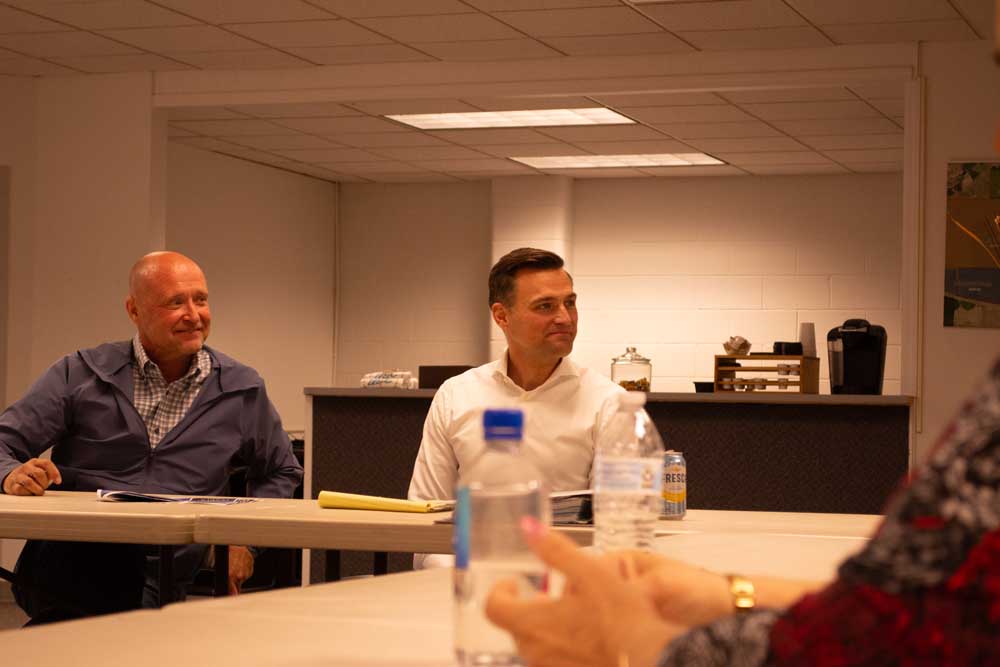Equine dental care is important too
Published 3:32 pm Friday, October 17, 2008

- Dr. Vetter examines Osmin’s horse’s teeth once inside.
Traveling horse dentist Dr. Richard Vetter tended several patients Oct. 6 at a small ranch near the Dun Rollin’ Trailer Park in Hermiston.
Trending
He and his assistant and wife, Kathy, treat horses in a custom trailer fitted with a chute, X-ray equipment, the tools of their trade, and a computer. There is even a sleeping area for the Vetters for when they are on the road from their Washington state home.
Tabitha Ritzer, the owner of the ranch, said she likes to have a dentist look at her horses at least once a year. She gives riding lessons and shows her horses at events such as the World Championship Appaloosa Show in Fort Worth, Texas. Ritzer was a veterinarian technician for nine years, and has seen some of the damage that can occur in horses’ mouths if their teeth are ignored.
“Most people don’t look at their horse’s teeth until they’re older, and then they’re all gone. It really helps them live longer to have regular dental care,” she said.
Trending
Ritzer called the Vetters because they are something of a dream team in the field. Before Richard decided to specialize in equine dentistry, he was a “mixed practice” veterinarian, meaning he treated large and small animals. He also worked for the federal government as a specialist in foreign animal diseases.
But the need for a doctor who really knew what he is doing in a horse’s mouth, he said, was strong.
“Everyday veterinarians don’t have a lot of training and knowledge on equine dentistry, and they don’t often do a very good job,” Vetter said.
The Vetters have seen horses that, even with regular dental care from a veterinarian, for years carry infections stemming from tooth decay or uneven wear of their teeth.
One horse had such severe periodontal disease that he had broken his jaw while trying to eat, and three different veterinarians had not been able to figure out what was wrong with him.
Richard said that, during their training, veterinarians learn a little about a lot of things – they have to retain information about virtually every animal from chickens to primates, he said, which doesn’t leave a lot of room for in-depth learning about one topic, such as equine dentistry.
To break down tough hay and grain, horses must grind them to small particles with their teeth. But when the action of their jaw is unbalanced, or they wear their teeth down in an uneven way, points or hooks in their teeth can develop. The sharp points dig into the horse’s mouth or gums, causing infections or making it impossible for them to chew properly. A sure sign that a horse has dental problems is when food falls out of their mouth when they eat or they cannot gain weight; some horses even have starved to death because they could not chew their food.
“You can feed a horse all you want, but if they can’t grind it, they can’t eat it,” Kathy said.
Good dental care for a horse, Richard said, starts early.
“I like to see horses for the first time when they are 18 months old, because they are creating conditions in their mouth that will affect them the rest of their lives” Vetter said.
To become an equine dentist, Vetter apprenticed with several experts in the field, took classes at the University of Minnesota and earned a certificate from the International Association of Equine Dentists. He teaches at horse meetings and conventions around the country.
Kathy Vetter, although not a veterinarian, is just as passionate about horse teeth as her husband. On the walls of their trailer are pictures of horse periodontal disease and cavities, which she eagerly explains to those interested.
At the ranch, Vetter sedated Amy, a 5-year-old quarter horse, and then led her to the trailer. Amy walked up to the ramp leading to the treatment chute and then stopped, eyeing the chute warily.
“This is a prey animal, and we’re asking her to come into a den,” Kathy explained.
After several minutes of “C’mon, Amy. C’mon, sweetheart,” Richard finally resorted to picking up Amy’s feet one by one and moving them into the chute. Once inside, she stood with her feet slightly splayed, a glazed look in her eye.
Richard placed her head on a padded stand and then clamped her mouth open with a brace. Wearing a headset fitted with a flashlight, he looked into Amy’s toothy jaw with a small mirror attached to a pointer.
“You see these ulcers on the inside of her cheeks? That is the result of sharp points forming on her teeth,” he said. Vetter also noticed scarring along Amy’s tongue, which could have been caused by cheat grass in her feed.
After his examination, Vetter got out a motorized sanding tool and went to work on Amy’s teeth, which were worn unevenly.
“She’s not symmetrical, but she’s got a pretty good mouth for her age,” Vetter said. Without care, he said, Amy would most likely have had serious dental problems within five to 10 years.
“We can make their lives a whole lot better,” he said.









